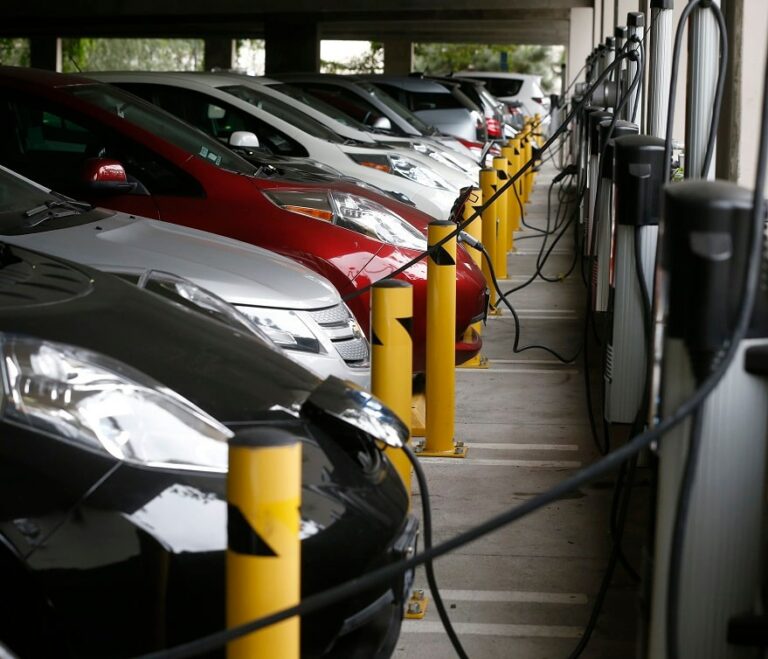EV Adoption to Drive New Grid Integration Tools, Experts Say
The rapid growth of electric vehicles (EVs) in the United States is poised to reshape how utilities and grid operators manage electricity loads and expand their power networks, according to recent analysis.
Although previous administrations have adjusted EV targets and funding, experts anticipate strong EV deployment driven by sustained automaker commitments, state-level policies, consumer trends, and decreasing battery prices.
Rabobank estimates that EVs could add between 100 and 185 terawatt-hours (TWh) to U.S. electricity demand by 2030, representing 2.5% to 4.6% of the country’s total electricity consumption. PwC anticipates that EVs may account for approximately 30% of all U.S. sales by 2030, as manufacturers introduce more affordable models. By 2040, EV adoption should be closer to 60% of U.S. light-duty vehicle sales, with EV load rising from an estimated 24 TWh in 2023 to 468 TWh by 2040.

Grid operators must also address the challenges of integrating intermittent power sources, namely the growing capacity of renewable energy. Experts suggest that new grid management strategies, including managed and flexible EV charging, can reduce strain on the grid, improve reliability, and potentially postpone network upgrades.
Jaron Weston, manager of the California Energy Commission’s Zero Emission Vehicle Acceleration Branch, told Reuters Events that the full vehicle-to-grid (VGI) integration will require collaboration among automakers, charging companies, and utilities, as well as the seamless interaction of distinct technologies like EVs, chargers, and infrastructure.
EV batteries possess the potential to act as mobile power generators, feeding energy back into the grid and offering critical grid services such as load shifting, demand response, and peak shaving. Through programs like time-variable pricing with associated grid modernization, utilities can optimize EV integration and reduce grid stress.
Weston highlighted the significant grid benefits associated with vehicle-to-grid integration, stating, “Through vehicle-to-grid integration, electric vehicles represent substantially more potential for grid benefits than any other distributed resource.”
California and Texas are already experiencing grid resiliency challenges, according to Amit Mathrani, energy transition specialist within the RaboResearch Energy Transition team. California is dealing with the decline in solar generation during the evening, while Texas faces issues with high summer cooling demands and rapid load growth. California’s EV market, the largest in the country at 30% of all vehicles, and Nevada have the highest solar penetration rates. Texas is also seeing growth in both EV adoption and solar capacity.
Mathrani expressed concern that unmanaged EV charging and rising power demand could exacerbate peak demand stress. Furthermore, higher demand from building and heating electrification, along with EV adoption, may shift electricity demand profiles between 2030 and 2040 in the U.S. Northeast. “If we see EVs being adopted at a higher rate, we could go from being a summer-peaking system to a winter-peaking system, where essentially the demand for electricity in the winter will be higher than the demand in the summer… This will occur in the north because of the colder winters and a higher demand from the heating systems in the winter,” Mathrani said.
To help manage load, California has adopted time-of-use electricity rates to shift load and reduce pressure on the grid during peak-load periods between 4 and 9 pm, when rates are typically higher, according to Timothy Lipman, co-director of the Transportation Sustainability Research Center at the University of California Berkeley. In the hours before, there is often excess solar supply.
The next trend in electricity pricing for load management will involve energy prices fluctuating hourly based on “grid conditions,” Lipman said, citing a project he’s working on, as part of the California Load Flexibility Research and Development Hub (CalFlexHub), a program that develops research on load flexible technologies. In this model, utility companies would provide “day-ahead”, “hour-ahead” and even “15-minute ahead” forecasts on grid demand and power prices. Automakers could then provide the car owner with the lowest-cost charging schedule based on time available, which would also help reduce peak load.
The CEC has awarded $208 million across 10 projects to provide mass adoption of vehicle-to-grid services based on hourly-dynamic rate signals and bi-directional projects, as part of a portfolio of initiatives to support vehicle-to-grid integration. According to CEC’s Weston, real-world deployments have validated the technological feasibility of the most advanced forms of vehicle-to-grid integration.
Weston added that to unlock the full value of VGI, the industry needs, “continued deployment of widely available economic signals and improved inter-operability standards that underlie VGI services, so drivers only worry about plugging in, and everything else just works.”
Akshay Singh, a partner in PwC’s U.S. Automotive Practice, believes that utilities and grid operators must collaborate with regulatory bodies to approve new electricity rate structures and educate customers on the advantages of time-of-use rates. Through time-of-use rates and other incentives, utilities could mitigate the impacts of EV growth and also use EV load “as a virtual energy storage asset, to enable increased renewable energy utilization,” Singh concluded.



